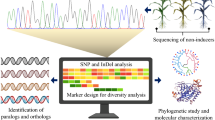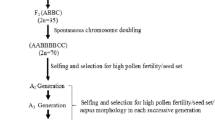Abstract
In Lilium, a popular horticulture crop, the main objective of crossbreeding is introgression of desirable genes and features into new cultivars. Commercial Lilium cultivars were produced primarily through 2n-gametes or 2x-gametes as parental plants or backcrossing. The primary genetic difference in 2 methods, is the presence of genomic recombination. Especially, GISH (genomic in situ hybridization) among molecular cytogenetic analysis, is the relevant technique to detect genetic information; genome composition, chromosome behavior during meiosis and recombination of hybrids as using their parental DNA as a probe. Based on previous studies, in this research, 12 LA (L. longiflorum x L. Asiatic hybrids) hybrids were analyzed by GISH (genomic in situ hybridization) along with ploidy analysis, and pollen germination tests. The LA hybrids used in this study, showed less pollen germination ability (ranged 0 - 21.74%), but germination of ‘Caesars Palace’ was significantly higher (59.09%). Interestingly, ploidy analysis showed that ‘Caesars Palace’ was tetraploid and ‘Batistero’ had one more additional chromosome from the L genome. Nine of the 12 cultivars exhibited recombination and 3 had only non-recombinant chromosomes; fewer L. longiflorum chromosomes were present in the cultivars than Asiatic chromosomes. Consequentially, it is assumed that 2n-gametes were more common methodology than 2x-gametes for producing commercial cultivars. Moreover, backcrossing tended to be performed with the Asiatic hybrid cultivar.
Similar content being viewed by others
References
Anonymous (2016) CBI Trade Statistics: Cut Flowers and Foliage. CBI Ministry of Foreing Affairs, The Hague, The Netherlands, p 7
Asano Y (1978) Studies on crosses between distantly related species of lilies. III. New hybrids obtained through embryo culture. Jpn Soc Hortic Sci 47:401–414
Asano Y (1980) Studies on crosses between distantly related species of lilies. V. Characteristics of newly obtained hybrids through embryo culture. Jpn Soc Hortic Sci 49:241–250
Asano Y (1982) Chromosome association and pollen fertility in some interspecific hybrids of Lilium. Euphytica 31:121–128
Asano Y, Myodo H (1997) Studies on crosses between distantly related species of lilies I. For the intrastylar pollination techique. Jpn Soc Hortic Sci 46:59–65
Ascher P (1973) Preliminary report of interspecific hybrids from the cross L. × ‘Damson’ × L. longiflorum. Lily Yearb Ed 26. N. Am. Lily Society, New York, USA, pp 73–81
Barba-Gonzalez R, Lim K-B, Van Tuyl J (2014) Molecular Cytogenetics in Lilium Breeding. Acta Hortic 1027:129–142
Barba-Gonzalez R, Ramanna MS, Visser RG, Van Tuyl J (2005) Intergenomic recombination in F1 lily hybrids (Lilium) and its significance for genetic variation in the BC1 progenies as revealed by GISH and FISH. Genome 48:884–894
BKD (2015) Voorlopige oppervlaktestatistiek lelie 2015. Available via http://www.bkd.eu/nieuws/voorlopige-oppervlaktestatistiek-lelie-2015/. Accessed 21 July 2015
Blakeslee AF, Avery AG (1937) Methods of inducing doubling of chromosomes in plants by treatment with colchicine. J Hered 28:393–411
Buschman J (2005) Globalisation-flower-flower bulbs-bulb flowers. Acta Hortic 673:27–33
CIMMYTY Economics Program International Maize & Wheat Improvement Center (1993) The adoption of agricultural technology: a guide for survey design. CIMMYT, Texcoco, Mexico, pp 174-179
Comber HF (1949) A new classification of the genus Lilium. Lily Yearb, Ed 15. N. Am. Lily Society, New York, USA, pp 86–105
De Jong P (1974) Some notes on the evolution of lilies. Lily Yearb Ed 27. N. Am. Lily Society, New York, USA, pp 23–28
Devi J, Ko J, Seo B (2005) FISH and GISH: Modern cytogenetic techniques. Indian J Biotechnol 4:307–315
Emsweller S, Brierley P (1940) Colchicine-induced tetraploidy in Lilium. J Hered 31:223–230
Jones N, Houben A (2003) B chromosomes in plants: escapees from the A chromosome genome? Trends Plant Sci 8:417–423
Joung HY, Cho HR, Rhee JH, Shin HK, Park SK (2015) Breeding of a multi-flowering and early-flowering white calla lily cultivar ‘White Cutie’ resistant to soft rot eisease. Korean J Hortic Sci Technol 33:618–623
Kamstra A (1993) The effect of size grading on individual growth in eel, Anguilla anguilla, measured by individual marking. Aquaculture 112:67–77
Kanazawa A, Tsutsumi N (1992) Extraction of restrictable DNA from plants of the genus Nelumbo. Plant Mol Biol Rep 10:316–318
Karlov G, Khrustaleva L, Lim K, Van Tuyl J (1999) Homoeologous recombination in 2 n-gametes producing interspecific hybrids of Lilium (Liliaceae) studied by genomic in situ hybridization (GISH). Genome 42:681–686
Lighty R (1968) Evolutionary trends in lilies. Royal Horticultural Society of Lily Yearbook Ed 31.Royal Horticultural Society, London, UK, pp 40–44
Lim K-B, Barba-Gonzalez R, Zhou S, Ramanna MS, Van Tuyl JM (2008) Interspecific hybridization in lily (Lilium): taxonomic and commercial aspects of using species hybrids in breeding. Floric Ornam Plant Biotechnol 5:146–151
Lim K-B, Ramanna MS, de Jong JH, Jacobsen E, Van Tuyl J (2001a) Indeterminate meiotic restitution (IMR): a novel type of meiotic nuclear restitution mechanism detected in interspecific lily hybrids by GISH. Theor Appl Genet 103:219–230
Lim K-B, Ramanna MS, van Tuyl J, Lokker A, Barba-Gonzalez R (2004) Genotypic and environmental variation in production of 2n-gametes of oriental x asiatic lily hybrids. Acta Hortic 673:453–456
Lim K-B, Van Tuyl JM (2007) Lily. Lilium hybrids. In Anderson NO, Ed, Flower Breeding and Genetics: Issues, Challenges and Opportunities for The 21 st Century, Chapter 19. Springer, Dordrecht, The Netherlands, pp 517–537
Lim K-B, Wennekes J, Jong JHd, Jacobsen E, Van Tuyl JM (2001b) Karyotype analysis of Lilium longiflorum and Lilium rubellum by chromosome banding and fluorescence in situ hybridisation. Genome 44:911–918
Lukaszewski A, Curtis C (1993) Physical distribution of recombination in B-genome chromosomes of tetraploid wheat. Theor Appl Genet 86:121–127
MacRae EA (1998) Lilies: a guide for growers and collectors. Timber Press, Portland, USA, pp 211–238
North C, Wills A (1969) Inter-specific hybrids of Lilium lankongense Franchet produced by embryo-culture. Euphytica 18:430–434
Ramanna MS (1992) The use of 2n gametes in breeding polysomic polyploid species; some achievements and perspectives. In A. Mariani & S. Tavoletti (Eds.), Gametes with Somatic Chromosome Number in the Evolution and Breeding of Polyploid Polysomic Species: Achievements and Perspectives, Perugia, Italy, pp 91–99
Ramanna MS, Jacobsen E (2003) Relevance of sexual polyploidization for crop improvement–A review. Euphytica 133:3–8
Shimizu M (1987) The Lilies of Japan, Species and Hybrids. Seibundo Shinkosha, Tokyo, Japan, pp 148–165
Skirm GW (1942) Embryo culturing as an aid to plant breeding. J Hered 33:211–215
Stewart RN (1947) The morphology of somatic chromosomes in Lilium. Am J Bot 9–26
van Tuyl JM, de Vries JN, Bino RJ, Kwakkenbos TA (1989) Identification of 2n-pollen producing interspecific hybrids of Lilium using flow cytometry. Cytologia 54:737–745
Van Tuyl JM, Lim K-B (2003) Interspecific hybridisation and polyploidisation as tools in ornamental plant breeding. Acta Hortic 612:13–22
Van Tuyl JM, Meijer B, van Diën MP (1992) The use of oryzalin as an alternative for colchicine in in-vitro chromosome doubling of Lilium and Nerine. Acta Hortic 325:625–630
Xie S, Marasek-Ciolakowska A, Ramanna MS, Arens P, Visser RG, van Tuyl JM (2014) Characterization of B chromosomes in Lilium hybrids through GISH and FISH. Plant Syst Evol 300:1771–1777
Author information
Authors and Affiliations
Corresponding author
Rights and permissions
About this article
Cite this article
Kwon, MJ., Ramzan, F., Ahn, YJ. et al. Chromosomal analysis of Lilium longiflorum x Asiatic hybrids using GISH (genomic in situ hybridization). Hortic. Environ. Biotechnol. 58, 591–600 (2017). https://doi.org/10.1007/s13580-017-0019-2
Received:
Revised:
Accepted:
Published:
Issue Date:
DOI: https://doi.org/10.1007/s13580-017-0019-2




